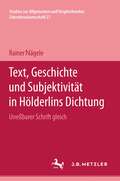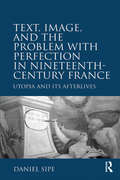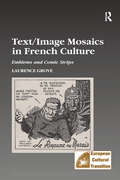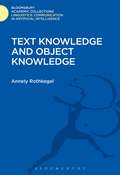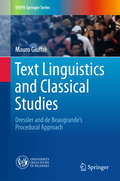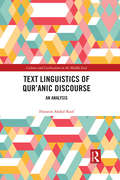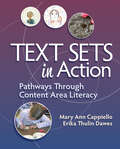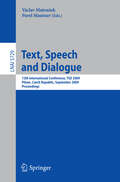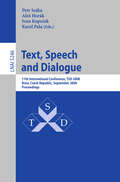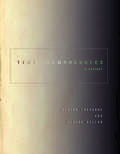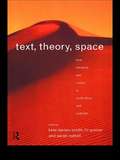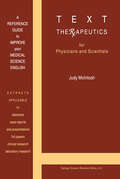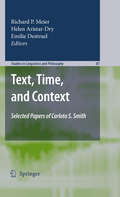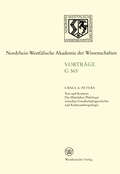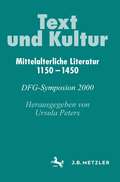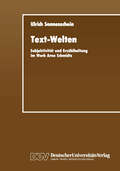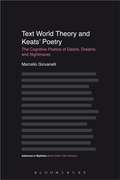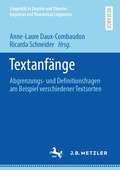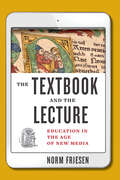- Table View
- List View
Text, Geschichte und Subjektivität in Hölderlins Dichtung: Studien zur Allgemeinen und Vergleichenden Literaturwissenschaft, Band 27
by Rainer NägeleText, Image, and the Problem with Perfection in Nineteenth-Century France: Utopia and Its Afterlives
by Daniel SipeIn the decades after the French Revolution, philosophers, artists, and social scientists set out to chart and build a way to a new world and their speculative blueprints circulated like banknotes in a parallel economy of ideas. Examining representations of ideal societies in nineteenth-century French culture, Daniel Sipe argues that the dream-image of the literary or art-historical utopia does not disappear but rather is profoundly altered by its proximity to the social utopianism of the day. Sipe focuses on this persistent afterlife in utopias ranging from François-René de Chateaubriand’s Amerindian utopia in Atala (1801) to the utopian spoof of J.J. Grandville’s illustrated novel Un autre monde (1844). He proposes a new reading of Etienne Cabet’s seminal utopian novel, Voyage en Icarie (1840) and offers an original perspective on the gendered utopias of technological inspiration that authors such as Charles Barbara and Auguste Villiers de l’Isle-Adam penned in the second half of the century. In addition, Sipe considers utopias or important readings of the century’s rampant utopianism in, among others, Victor Hugo, Alfred de Vigny, Théophile Gautier, Charles Baudelaire, and Gustave Courbet. His book provides the historical context for comprehending the significance and implications of this enigmatic afterlife in nineteenth-century utopian art and literature.
Text, Image, and the Problem with Perfection in Nineteenth-Century France: Utopia and Its Afterlives
by Daniel SipeIn the decades after the French Revolution, philosophers, artists, and social scientists set out to chart and build a way to a new world and their speculative blueprints circulated like banknotes in a parallel economy of ideas. Examining representations of ideal societies in nineteenth-century French culture, Daniel Sipe argues that the dream-image of the literary or art-historical utopia does not disappear but rather is profoundly altered by its proximity to the social utopianism of the day. Sipe focuses on this persistent afterlife in utopias ranging from François-René de Chateaubriand’s Amerindian utopia in Atala (1801) to the utopian spoof of J.J. Grandville’s illustrated novel Un autre monde (1844). He proposes a new reading of Etienne Cabet’s seminal utopian novel, Voyage en Icarie (1840) and offers an original perspective on the gendered utopias of technological inspiration that authors such as Charles Barbara and Auguste Villiers de l’Isle-Adam penned in the second half of the century. In addition, Sipe considers utopias or important readings of the century’s rampant utopianism in, among others, Victor Hugo, Alfred de Vigny, Théophile Gautier, Charles Baudelaire, and Gustave Courbet. His book provides the historical context for comprehending the significance and implications of this enigmatic afterlife in nineteenth-century utopian art and literature.
Text/Image Mosaics in French Culture: Emblems and Comic Strips (Studies in European Cultural Transition)
by Laurance GroveThis study compares text/image interaction as manifested in emblem books (and related forms) and the modern bande dessinée, or French-language comic strip. It moves beyond the issue of defining the emblematic genre to examine the ways in which emblems - and their modern counterparts - interact with the surrounding culture, and what they disclose about that culture. Drawing largely on primary material from the Bibliothèque nationale de France and from Glasgow University Library's Stirling Maxwell Collection of emblem literature, Laurence Grove builds on the ideas of Marshall McLuhan, Elizabeth Eisenstein and, more recently, Neil Rhodes and Jonathan Sawday. Divided into four sections-Theoretics, Production, Thematics and Reception-Text/Image Mosaics in French Culture broaches topics such as theoretical approaches (past and present) to text/image forms, the question of narrative within the scope of text/image creations, and the reuse of visual iconography for diametrically opposed political or religious purposes. The author argues that, despite the gap in time between the advent of emblems and that of comic strips, the two forms are analogous, in that both are the products of a 'parallel mentality'. The mindsets of the periods that popularised these forms have certain common features related to repeated social conditions rather than to the pure evolution over time. Grove's analysis and historical contextualisation of that mentality provide insight into our own popular culture forms, not only the comic strip but also other hybrid media such as advertising and the Internet. His juxtaposition of emblems and the bande dessinée increases our understanding of all such combinations of picture and text.
Text/Image Mosaics in French Culture: Emblems and Comic Strips (Studies in European Cultural Transition)
by Laurance GroveThis study compares text/image interaction as manifested in emblem books (and related forms) and the modern bande dessinée, or French-language comic strip. It moves beyond the issue of defining the emblematic genre to examine the ways in which emblems - and their modern counterparts - interact with the surrounding culture, and what they disclose about that culture. Drawing largely on primary material from the Bibliothèque nationale de France and from Glasgow University Library's Stirling Maxwell Collection of emblem literature, Laurence Grove builds on the ideas of Marshall McLuhan, Elizabeth Eisenstein and, more recently, Neil Rhodes and Jonathan Sawday. Divided into four sections-Theoretics, Production, Thematics and Reception-Text/Image Mosaics in French Culture broaches topics such as theoretical approaches (past and present) to text/image forms, the question of narrative within the scope of text/image creations, and the reuse of visual iconography for diametrically opposed political or religious purposes. The author argues that, despite the gap in time between the advent of emblems and that of comic strips, the two forms are analogous, in that both are the products of a 'parallel mentality'. The mindsets of the periods that popularised these forms have certain common features related to repeated social conditions rather than to the pure evolution over time. Grove's analysis and historical contextualisation of that mentality provide insight into our own popular culture forms, not only the comic strip but also other hybrid media such as advertising and the Internet. His juxtaposition of emblems and the bande dessinée increases our understanding of all such combinations of picture and text.
Text Knowledge and Object Knowledge (Linguistics: Bloomsbury Academic Collections)
by Annely RothkegelRothkegel argues that text production is the result of interaction between text knowledge and object knowledge – the conventional ordering and presentation of knowledge for communicative purposes and the conceptual organisation of world knowledge.
Text Linguistics and Classical Studies: Dressler and De Beaugrande’s Procedural Approach (UNIPA Springer Series)
by Mauro GiuffrèThe work represents a significant scientific advancement on text linguistics from three different viewpoints. The first chapter provides an overview of the history of text linguistics from a broader perspective than usual, offering a complete reference framework. The second chapter presents the procedural approach to the study of text linguistics in a concise way, including a critical comparison with other perspectives. The third chapter constructs a very unusual bridge between theoretical linguistics and classical studies in that it takes a literary text in Latin from the early imperial period as its case study. This combination is rare, as theoretical linguists are usually oriented to modern languages and classicists are not generally inclined to the study of formal linguistics. It also offers an interesting perspective that intersects the studies of general linguistics and glottology, which makes this volume of interest to general linguists, classicists, philologists and literary critics alike.
Text Linguistics of Qur'anic Discourse: An Analysis (Culture and Civilization in the Middle East)
by Hussein Abdul-RaofText Linguistics of Qur'anic Discourse is an in-depth investigation of the fabric of Qur'anic Discourse. It unravels the texture of the macro Qur'anic text; its cohesion and coherence systems; the notions of intertextuality, semantic relatedness, and thematic sequentiality; the macro textual features of ellipsis, repetition, and argumentation structure; and the contextual, co-textual, grammatical, and semantic factors involved in the macro Qur'anic text. This book is a valuable and methodologically consistent learning and teaching academic resource for universities worldwide in this intriguing new discipline. Through its methodologically coherent discussion and in-depth analysis that is hinged upon modern European text linguistics, Text Linguistics of Qur'anic Discourse provides an insight into the newly established discipline of text linguistics, and explores the different layers of the macro Qur'anic text as an academic requirement.
Text Linguistics of Qur'anic Discourse: An Analysis (Culture and Civilization in the Middle East)
by Hussein Abdul-RaofText Linguistics of Qur'anic Discourse is an in-depth investigation of the fabric of Qur'anic Discourse. It unravels the texture of the macro Qur'anic text; its cohesion and coherence systems; the notions of intertextuality, semantic relatedness, and thematic sequentiality; the macro textual features of ellipsis, repetition, and argumentation structure; and the contextual, co-textual, grammatical, and semantic factors involved in the macro Qur'anic text. This book is a valuable and methodologically consistent learning and teaching academic resource for universities worldwide in this intriguing new discipline. Through its methodologically coherent discussion and in-depth analysis that is hinged upon modern European text linguistics, Text Linguistics of Qur'anic Discourse provides an insight into the newly established discipline of text linguistics, and explores the different layers of the macro Qur'anic text as an academic requirement.
Text Sets in Action: Pathways Through Content Area Literacy
by Mary Ann Cappiello Erika Thulin DawesFinding ways to organize your classroom instruction for knowledge building and literacy learning can be challenging. How can you incorporate more nonfiction and informational text in your content area curriculum while expanding and deepening representation with diverse texts? What can motivate student learning while providing equity and access for different learning styles and needs? Text sets are the answer!In Text Sets in Action: Pathways Through Content Area Literacy, authors Erika Thulin Dawes and Mary Ann Cappiello demonstrate how text sets offer students the opportunity to build critical thinking skills and informational literacy while generating interest and engagement across the content areas. Put your students in the center of the meaning-making in your classroom with multimodal multi-genre text sets in action. In Text Sets in Action, the authors: Model how text sets build foundational skills and metacognitive strategies as students experience a carefully scaffolded and sequenced exploration of ideas, academic, and content vocabularyExplain how text sets encourage classroom discussion by having students ask questions about what they read, debate different perspectives, and relate the texts to their own personal experiences and the changes they would like to see in the worldShow how children's literature and multimodal, multi-genre texts can serve as mentor texts for student writing and inspire creativity and advocacyDemonstrate how to curate text sets that can introduce diverse and underrepresented voices into the classroom, fostering appreciation for different points of view and generate deeper critical thinkingProvide resources and suggestions for designing text sets a multimodal, multi-genre text set can include children's literature of all genres, as well as digital texts, YouTube videos, news articles, podcasts, and more Text Sets in Action will help you create a collection of text sets that can be added to or edited over the years to align with your lesson plan goals. Teachers who have adopted this approach saw greater student reading comprehension and critical thinking skills. By introducing a multitude of text, teachers will ignite a spirit of inquiry and engagement for lifelong learning.
Text Sets in Action: Pathways Through Content Area Literacy
by Mary Ann Cappiello Erika Thulin DawesFinding ways to organize your classroom instruction for knowledge building and literacy learning can be challenging. How can you incorporate more nonfiction and informational text in your content area curriculum while expanding and deepening representation with diverse texts? What can motivate student learning while providing equity and access for different learning styles and needs? Text sets are the answer!In Text Sets in Action: Pathways Through Content Area Literacy, authors Erika Thulin Dawes and Mary Ann Cappiello demonstrate how text sets offer students the opportunity to build critical thinking skills and informational literacy while generating interest and engagement across the content areas. Put your students in the center of the meaning-making in your classroom with multimodal multi-genre text sets in action. In Text Sets in Action, the authors: Model how text sets build foundational skills and metacognitive strategies as students experience a carefully scaffolded and sequenced exploration of ideas, academic, and content vocabularyExplain how text sets encourage classroom discussion by having students ask questions about what they read, debate different perspectives, and relate the texts to their own personal experiences and the changes they would like to see in the worldShow how children's literature and multimodal, multi-genre texts can serve as mentor texts for student writing and inspire creativity and advocacyDemonstrate how to curate text sets that can introduce diverse and underrepresented voices into the classroom, fostering appreciation for different points of view and generate deeper critical thinkingProvide resources and suggestions for designing text sets a multimodal, multi-genre text set can include children's literature of all genres, as well as digital texts, YouTube videos, news articles, podcasts, and more Text Sets in Action will help you create a collection of text sets that can be added to or edited over the years to align with your lesson plan goals. Teachers who have adopted this approach saw greater student reading comprehension and critical thinking skills. By introducing a multitude of text, teachers will ignite a spirit of inquiry and engagement for lifelong learning.
Text, Speech and Dialogue: 12th International Conference, TSD 2009, Pilsen, Czech Republic, September 13-17, 2009. Proceedings (Lecture Notes in Computer Science #5729)
by Vaclav Matousek Pavel MautnerText, Speech and Dialogue: 11th International Conference, TSD 2008, Brno, Czech Republic, September 8-12, 2008, Proceedings (Lecture Notes in Computer Science #5246)
by Petr Sojka Ales Horak Ivan KopecekThe annual Text, Speech and Dialogue Conference (TSD), which originated in 1998, is now starting its second decade. So far almost 900 authors from 45 countries have contributed to the proceedings. TSD constitutes a recognizedplatform for the presen- tion and discussion of state-of-the-art technology and recent achievements in the ?eld of natural language processing. It has become an interdisciplinary forum, interweaving the themes of speech technology and language processing. The conference attracts - searchers not only from Central and Eastern Europe, but also from other parts of the world. Indeed, one of its goals has always been to bring together NLP researchers with different interests from different parts of the world and to promote their mutual co- eration. One of the ambitions of the conference is, as its title says, not only to deal with dialogue systems as such, but also to contribute to improving dialogue between researchers in the two areas of NLP, i. e. , between text and speech people. In our view, the TSD conference was successful in this respect in 2008 as well. This volume contains the proceedings of the 11th TSD conference, held in Brno, Czech Republic in September 2008. Following the review process, 79 papers were - ceptedoutof173submitted,anacceptancerateof45. 7%.
Text Technologies: A History (Stanford Text Technologies)
by Elaine Treharne Claude WillanThe field of text technologies is a capacious analytical framework that focuses on all textual records throughout human history, from the earliest periods of traceable communication—perhaps as early as 60,000 BCE—to the present day. At its core, it examines the material history of communication: what constitutes a text, the purposes for which it is intended, how it functions, and the social ends that it serves. This coursebook can be used to support any pedagogical or research activities in text technologies, the history of the book, the history of information, and textually based work in the digital humanities. Through careful explanations of the field, examinations of terminology and themes, and illustrated case studies of diverse texts—from the Cyrus cylinder to the Eagles' "Hotel California"—Elaine Treharne and Claude Willan offer a clear yet nuanced overview of how humans convey meaning. Text Technologies will enable students and teachers to generate multiple lines of inquiry into how communication—its production, form and materiality, and reception—is crucial to any interpretation of culture, history, and society.
Text, Theory, Space: Land, Literature and History in South Africa and Australia
by Kate Darian-Smith Liz Gunner Sarah NuttallText, Theory, Space is a landmark in post-colonial criticism and theory. Focusing on two white settler societies, South Africa and Australia, the contributors investigate the meaning of 'the South' as an aesthetic, political, geographical and cultural space. Drawing upon a wide range of disciplines which include literature, history, urban and cultural geography, politics and anthropology, the contributors examine crucial issues including: * defining what 'the South' encompasses * investigating ideas of space, history, land and landscape * claiming, naming and possessing land * national and personal boundaries * questions of race, gender and nationalism
Text, Theory, Space: Land, Literature and History in South Africa and Australia
by Kate Darian-Smith Liz Gunner Sarah NuttallText, Theory, Space is a landmark in post-colonial criticism and theory. Focusing on two white settler societies, South Africa and Australia, the contributors investigate the meaning of 'the South' as an aesthetic, political, geographical and cultural space. Drawing upon a wide range of disciplines which include literature, history, urban and cultural geography, politics and anthropology, the contributors examine crucial issues including: * defining what 'the South' encompasses * investigating ideas of space, history, land and landscape * claiming, naming and possessing land * national and personal boundaries * questions of race, gender and nationalism
Text Therapeutics
by J. McIntoshText Therapeutics was written specifically for medical science professionals whose mother tongue is not English. Its objective is to assist non-native English- speaking physicians or scientists in the task of writing research documents for medical journals and/or oral presentations for medical congresses. Text Therapeutics incorporates a simplified methodology, which: provides a `follow-the-formula' analysis and gives concise explanations; offers convenient categorized side-headings which pinpoint the English text problem; and utilizes a format which is easily understood and applicable to any medical field. Text Therapeutics includes additional sections: Word Order; Useful Usage; A-Ω An English Lexicon - Words derived from Greek; and A-Z Glossary Guide - `Instructions for Authors'.
Text, Time, and Context: Selected Papers of Carlota S. Smith (Studies in Linguistics and Philosophy #87)
by Richard P. Meier Helen Aristar-Dry Emilie DestruelCarlota S. Smith was a key figure in linguistic research and a pioneering woman in generative linguistics. This selection of papers focuses on the research into tense, aspect, and discourse that Smith completed while Professor of Linguistics at the University of Texas at Austin. Smith’s early work in English syntax is still cited today, and her early career also yielded key research on language acquisition by young children. Starting in the mid-1970s, after her move to UT, she embarked on her most important line of research. In numerous papers - the first of which was published in 1975 - and in a very important 1991 book (The Parameter of Aspect), Smith analyzed how languages encode time and how they encode the ways events and situations occur over time. Smith’s work on the expression of time in language is notable because of its careful analyses of a number of quite different languages, including not only English and French, but also Russian, Mandarin, and Navajo. Inspired by a year in France in the early 1970s, Smith began to analyze the differing ways in which languages encode time and how they encode the ways events and situations occur over time. In doing so, she developed her signature ‘two-component’ theory of aspect. This model of temporal aspect provided an excellent framework for graduate students seeking to analyze the temporal systems of an array of languages, including under-described languages that are so much the focus of research in UT’s Linguistics Department. Selected by Carlota Smith herself and by her longtime friends and colleagues, this book contains her 1980 piece on temporal structures in discourse, her 1986 comparison of the English and French aspectual systems, a 1996 paper on the aspect system in Navajo (an increasingly-endangered language which Smith worked to preserve), and her 1980 and 1993 papers on the child’s acquisition of tense and aspect. Smith, who died in 2007, was a trailblazer in her field whose broad interests fed into her scholarly research. She was an avid reader who sought to bring the analytic tools of linguistics to the humanistic study of literature, by examining the syntactic and pragmatic principles which underlie literary effects. Her research on rhetorical and temporal effects in context was integrated into her last book, Modes of Discourse (2003). The current volume of articles covers much of her most fruitful work on the way in which language is used to express time, and will be essential reading for many working and studying in linguistics generally and in semantics particularly.
Text und Kontext: Die Mittelalter-Philologie zwischen Gesellschftsgeschichte und Kulturanthropologie (Nordrhein-Westfälische Akademie der Wissenschaften #365)
by Ursula PetersText und Kultur: Mittelalterliche Literatur 1150–1450. DFG-Symposion 2000 (Germanistische Symposien)
Der Band zielt auf eine Standortbestimmung der Mediävistik zwischen Texttheorie und Kulturanthropologie. Dabei werden die verschiedenen Versuche einer mediävistischen Anknüpfung an neuere Text- und Kulturtheorien in ihren Auswirkungen auf Fragen von Textkonstitution, literarischer Funktionsgeschichte, von Epochenbestimmung und Werkverständnis ausgelotet.
Text World Theory and Keats' Poetry: The Cognitive Poetics of Desire, Dreams and Nightmares (Advances in Stylistics)
by Marcello GiovanelliText World Theory and Keats' Poetry applies advances in cognitive poetics and text world theory to four poems by the nineteenth century poet John Keats. It takes the existing text world theory as a starting point and draws on stylistics, literary theory, cognitive linguistics, cognitive psychology and dream theories to explore reading poems in the light of their emphasis on states of desire, dreaming and nightmares. It accounts for the representation of these states and the ways in which they are likely to be processed, monitored and understood. Text World Theory and Keats' Poetry advances both the current field of cognitive stylistics but also analyses Keats in a way that offers new insights into his poetry. It is of interest to stylisticians and those in literary studies.
Text World Theory and Keats' Poetry: The Cognitive Poetics of Desire, Dreams and Nightmares (Advances in Stylistics)
by Marcello GiovanelliText World Theory and Keats' Poetry applies advances in cognitive poetics and text world theory to four poems by the nineteenth century poet John Keats. It takes the existing text world theory as a starting point and draws on stylistics, literary theory, cognitive linguistics, cognitive psychology and dream theories to explore reading poems in the light of their emphasis on states of desire, dreaming and nightmares. It accounts for the representation of these states and the ways in which they are likely to be processed, monitored and understood. Text World Theory and Keats' Poetry advances both the current field of cognitive stylistics but also analyses Keats in a way that offers new insights into his poetry. It is of interest to stylisticians and those in literary studies.
Textanfänge: Abgrenzungs- und Definitionsfragen am Beispiel verschiedener Textsorten (Linguistik in Empirie und Theorie/Empirical and Theoretical Linguistics)
by Anne-Laure Daux-Combaudon Ricarda SchneiderAusgehend von der Annahme, dass ein Text das Ergebnis einer Kommunikationsabsicht ist, werden in den Beiträgen des Bandes eine Vielfalt von Textanfängen, die verschiedenen Textsorten angehören, und deren spezifische Besonderheiten untersucht. Den Beiträgen liegen sowohl schriftliche als auch mündliche Textkorpora zugrunde, die journalistische und politische Texte (Pressekommentare und Reden), Gebrauchstexte (Kochrezepte), Fachtexte (Verträge und Gesetze) sowie multimodale Texte (Werbeplakate und Direkt-Marketing-Texte) und Gespräche (Mutter-Kind-Interaktionen) einschließen. Die Analysen gehen von einem syntaktischen, semantischen, pragmatisch-sprechakttheoretischen, didaktischen und/oder textlinguistischen Standpunkt aus.
The Textbook and the Lecture: Education in the Age of New Media (Tech.edu: A Hopkins Series on Education and Technology)
by Norm FriesenWhy are the fundamentals of education apparently so little changed in our era of digital technology? Is their obstinate persistence evidence of resilience or obsolescence? Such questions can best be answered not by imagining an uncertain high-tech future, but by examining a well-documented past;¢;‚¬;€?a history of instruction and media that extends from Gilgamesh to Google. Norm Friesen looks to the combination and reconfiguration of oral, textual, and more recent media forms to understand the longevity of so many educational arrangements and practices.Friesen examines the interrelationship of reading, writing, and pedagogy in the case of the lecture and the textbook;¢;‚¬;€?from their premodern to their postmodern incarnations. Over hundreds of years, these two forms have integrated textual, oral, and (more recently) digital media and connected them with changing pedagogical and cultural priorities. The Textbook and the Lecture opens new possibilities for understanding not only mediated pedagogical practices and their reform but also gradual changes in our conceptions of the knowing subject and of knowledge itself.Drawing on wide-ranging scholarship in fields as diverse as media ecology and German-language media studies, Foucauldian historiography, and even archaeological research, The Textbook and the Lecture is a fascinating investigation of educational media.
